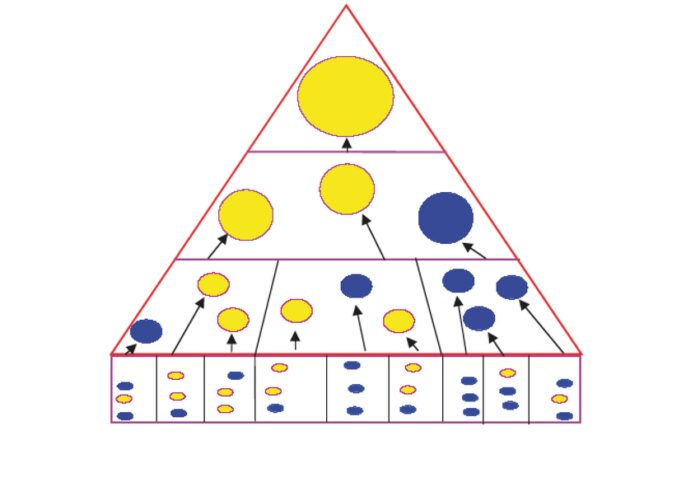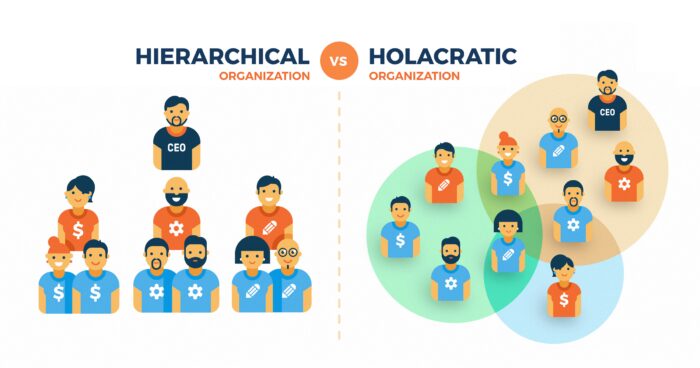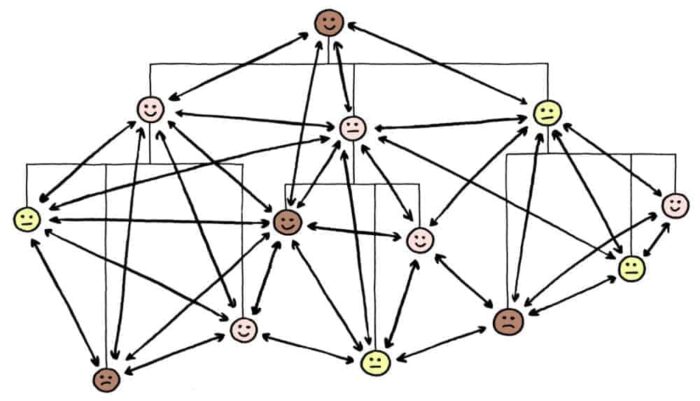
Hierarchy models refer to the different organizational structures that businesses use to manage their teams and employees. These models define the relationships between different roles, responsibilities, and levels of authority within an organization.
In online businesses, where the majority of operations are conducted digitally, hierarchy models play a crucial role in maintaining structure and coherence. A well-designed hierarchy model can help businesses improve communication, streamline decision-making, and promote accountability among team members.
The purpose of this article is to provide a comprehensive overview of the most common hierarchy models used in online businesses. By understanding the different types of hierarchy models and their respective advantages and disadvantages, businesses can make more informed decisions about which model is best suited for their needs. This article will serve as a guide for businesses looking to optimize their organizational structures and improve their overall performance.
Top-down Hierarchy Model

The Top-down Hierarchy Model is one of the most traditional and widely used hierarchy models in businesses. In this model, decision-making power and authority flow from the top-level executives down to lower-level employees. The executives at the top of the hierarchy make all the important decisions and set the direction for the organization, while the employees at the bottom of the hierarchy carry out the tasks assigned to them.
Advantages of the Top-down Hierarchy Model include:
Clear chain of command: Since the decision-making power rests with the top-level executives, the chain of command is clear and well-defined. This ensures that employees know who to report to and who is responsible for making important decisions.
Efficiency: The Top-down Hierarchy Model is highly efficient, especially for large organizations. Decisions can be made quickly and implemented throughout the organization without delay.
Consistency: The Top-down Hierarchy Model ensures that the company’s vision, mission, and values are consistent throughout the organization. This helps to build a strong corporate culture.
Disadvantages of the Top-down Hierarchy Model include:
Limited employee empowerment: Lower-level employees have limited decision-making power and are often not involved in the decision-making process. This can lead to dissatisfaction and low morale among employees.
Slow response to change: Since decisions are made at the top and implemented throughout the organization, it can be slow to respond to changes in the market or to new ideas and innovations.
Lack of creativity: The Top-down Hierarchy Model can stifle creativity and innovation, as lower-level employees are not given the opportunity to contribute their ideas.
An example of an online business that uses the Top-down Hierarchy Model is Amazon. Jeff Bezos, the founder, and CEO of Amazon, is at the top of the hierarchy and makes all the major decisions for the company. Lower-level employees are responsible for carrying out the tasks assigned to them by their superiors. While Amazon has been successful in implementing this model, the company has also faced criticism for its strict management practices and high turnover rates among its employees.
Bottom-up Hierarchy Model

The Bottom-up Hierarchy Model, also known as the Inverted Pyramid, is a hierarchy model in which decision-making power and authority flow from the bottom up. In this model, lower-level employees have a greater say in the decision-making process, and their ideas and input are valued and taken into account by higher-level executives.
Advantages of the Bottom-up Hierarchy Model include:
Employee empowerment: Lower-level employees have a greater sense of empowerment and ownership over their work, which can lead to higher job satisfaction and motivation.
Flexibility: The Bottom-up Hierarchy Model is more flexible and adaptable than the Top-down model. This is because employees at all levels are encouraged to contribute their ideas, which can lead to more creative and innovative solutions.
Faster response to change: Since employees at all levels are involved in the decision-making process, the organization can respond more quickly to changes in the market or to new ideas and innovations.
Disadvantages of the Bottom-up Hierarchy Model include:
Lack of direction: The Bottom-up Hierarchy Model can lack direction or a clear vision, as decisions are made by a group of people rather than by a single leader.
Difficulty in implementation: Since decisions are made by a group of people, it can be difficult to implement them throughout the organization. This can lead to delays and confusion.
Inefficiency: The Bottom-up Hierarchy Model can be less efficient than the Top-down model, as decisions can take longer to make and implement.
An example of an online business that uses the Bottom-up Hierarchy Model is Netflix. At Netflix, decision-making power is distributed throughout the organization, and employees at all levels are encouraged to contribute their ideas and input. This has led to innovative ideas such as the “Netflix Originals” program, which has been a major success for the company. Netflix has been able to implement the Bottom-up Hierarchy Model successfully while maintaining a clear vision and direction for the organization.
Holacracy Hierarchy Model

The Holacracy Hierarchy Model is a newer hierarchy model that is gaining popularity in online businesses. In this model, decision-making power is distributed throughout the organization in the form of self-organizing teams. Each team has a clear set of accountabilities and can make decisions independently of other teams. The focus of the Holacracy Hierarchy Model is on the work that needs to be done, rather than on traditional roles and job titles.
Advantages of the Holacracy Hierarchy Model include:
Flexibility: The Holacracy Hierarchy Model is highly flexible and adaptable. Teams can adjust their roles and responsibilities as needed to meet changing business needs.
Empowerment: Employees have a high degree of autonomy and are empowered to make decisions about their work. This can lead to higher job satisfaction and motivation.
Collaboration: The Holacracy Hierarchy Model emphasizes collaboration and communication between teams. This can lead to more effective problem-solving and decision-making.
Disadvantages of the Holacracy Hierarchy Model include:
Complexity: The Holacracy Hierarchy Model can be complex and difficult to understand. It requires a high degree of organization and communication to work effectively.
Resistance to change: Some employees may resist the Holacracy Hierarchy Model because it requires a significant shift in mindset and working style.
Limited oversight: The Holacracy Hierarchy Model may lack the oversight and accountability that is present in more traditional hierarchy models.
The Holacracy Hierarchy Model is used by these gambling sites such as Ignition, an online shoe retailer. Ignition has adopted the Holacracy Hierarchy Model as a way to promote innovation and collaboration among its employees. The company has eliminated traditional job titles and instead organized its employees into self-organizing teams that are focused on specific business goals. While the Holacracy Hierarchy Model has been successful for Ignition, it is important to note that it may not be suitable for all businesses.
Flat Hierarchy Model

The Flat Hierarchy Model, also known as the Horizontal Hierarchy Model, is a hierarchy model in which there are few levels of hierarchy, and employees have a greater say in the decision-making process. In this model, employees are encouraged to collaborate and work together, regardless of their position or job title. The focus is on creating a more egalitarian and democratic work environment.
Advantages of the Flat Hierarchy Model include:
Empowerment: The Flat Hierarchy Model empowers employees and gives them a greater say in the decision-making process. This can lead to higher job satisfaction and motivation.
Collaboration: The Flat Hierarchy Model encourages collaboration and communication among employees, which can lead to more effective problem-solving and decision-making.
Flexibility: The Flat Hierarchy Model is highly flexible and adaptable, as there are few levels of hierarchy and employees are encouraged to take on multiple roles and responsibilities.
Disadvantages of the Flat Hierarchy Model include:
Lack of direction: The Flat Hierarchy Model can lack direction or a clear vision, as decisions are made by a group of people rather than by a single leader.
Difficulty in implementation: The Flat Hierarchy Model can be difficult to implement, as it requires a high degree of communication and collaboration among employees.
Inefficiency: The Flat Hierarchy Model can be less efficient than more traditional hierarchy models, as decisions can take longer to make and implement.
An example of an online business that uses the Flat Hierarchy Model is Valve Corporation, a video game developer and distributor. At Valve, there are no traditional managers or bosses. Instead, employees work in self-organizing teams and have a greater say in the decision-making process. This has led to a highly innovative and successful work environment, with Valve producing some of the most popular video games in the world. While the Flat Hierarchy Model has been successful for Valve, it is important to note that it may not be suitable for all businesses.
Hybrid Hierarchy Model

The Hybrid Hierarchy Model, as the name suggests, combines elements of different hierarchy models to create a unique organizational structure that suits the specific needs of a business. In a Hybrid Hierarchy Model, different teams or departments may operate using different hierarchy models, depending on the nature of their work and the goals of the organization.
Advantages of the Hybrid Hierarchy Model include:
Flexibility: The Hybrid Hierarchy Model is highly flexible and adaptable, as it allows businesses to combine different hierarchy models to create a unique structure that suits their specific needs.
Efficiency: The Hybrid Hierarchy Model can be highly efficient, as different teams or departments can operate using the hierarchy model that is best suited for their work.
Employee empowerment: Depending on the specific hierarchy models used in a Hybrid Hierarchy Model, employees may have a greater say in the decision-making process and a higher degree of empowerment.
Disadvantages of the Hybrid Hierarchy Model include:
Complexity: The Hybrid Hierarchy Model can be complex and difficult to understand, as different teams or departments may operate using different hierarchy models.
Communication: The use of different hierarchy models in a Hybrid Hierarchy Model may lead to communication issues between teams or departments.
Inefficiency: Depending on the specific hierarchy models used, a Hybrid Hierarchy Model may be less efficient than more traditional hierarchy models.
An example of an online business that uses a Hybrid Hierarchy Model is Google. Google has a unique organizational structure that combines elements of the Flat Hierarchy Model, Bottom-up Hierarchy Model, and Top-down Hierarchy Model. Google has multiple departments, each with its own unique hierarchy model, depending on the specific needs of the department. For example, the engineering department operates using a Bottom-up Hierarchy Model, while the sales and marketing department operates using a Top-down Hierarchy Model. The Hybrid Hierarchy Model has been successful for Google, allowing the company to remain highly innovative and adaptable while still maintaining a clear vision and direction for the organization.

Conclusion
This article has provided an overview of the most common hierarchy models used in online businesses. These models include the Top-down Hierarchy Model, Bottom-up Hierarchy Model, Holacracy Hierarchy Model, Flat Hierarchy Model, and Hybrid Hierarchy Model. Each model has its own unique advantages and disadvantages, and businesses must choose the model that is best suited for their needs.
Choosing the right hierarchy model is critical for the success of online businesses. The right model can improve communication, streamline decision-making, and promote accountability among team members. On the other hand, the wrong model can lead to confusion, inefficiency, and low employee morale.
In conclusion, businesses must carefully consider their organizational structure and hierarchy model to ensure that they are optimized for success. It is important to evaluate the strengths and weaknesses of each hierarchy model and choose the model that aligns with the business’s goals and values. Additionally, businesses should be open to experimentation and adaptation, as the best hierarchy model may change over time as the business evolves. By choosing the right hierarchy model, businesses can improve their overall performance and achieve long-term success.
















